Za’atar Recipe
Za'atar is an incredibly versatile Middle Eastern spice blend, one of my favorites. Particularly this time of year when it's a welcome addition to all sorts of roasted vegetables, soups and stews, or simply sprinkled over everything from yogurt, to eggs, to savory granola.

Za'atar is a wonderfully tangy, herb-forward Middle Eastern spice blend. Do you know it? I'm sure a many of you do. It's the sort of ingredient that has become a staple in my kitchen. Right now it sits on my counter next to essentials like sea salt and olive oil. This is the time of year I find za'atar a welcome counterpoint to the sweetness of deeply roasted winter squash and a nice wildcard element in big hearty soups. It is ideal sprinkled generously over eggs of all kinds, and is just the right accent on everything from quiche to breakfast casseroles, labneh to pasta salad. It's just good all around.
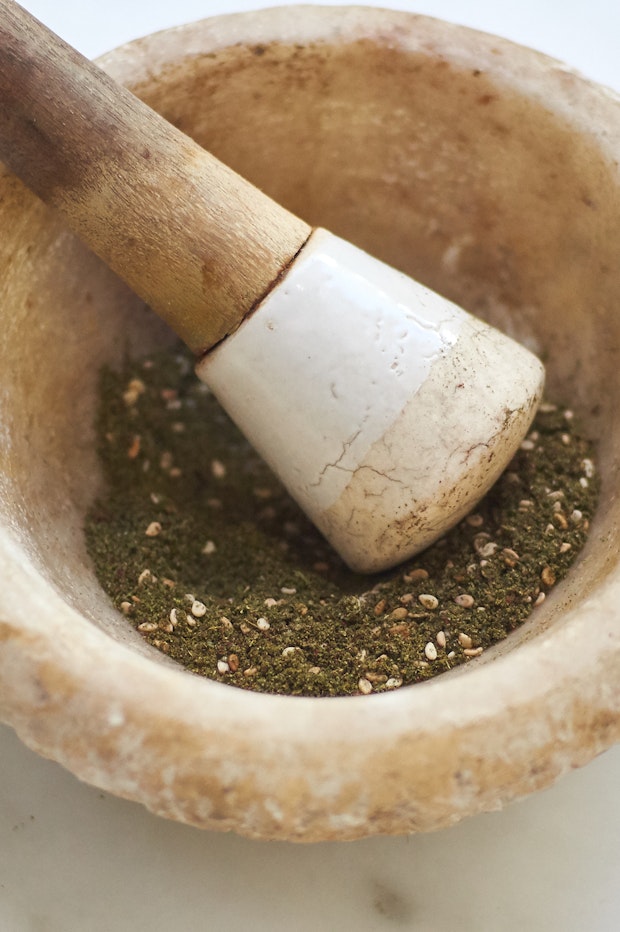
What is Za’atar?
Za’atar is a traditional Middle Eastern spice blend that varies from country to country, family to family, and cook to cook. Generally speaking it is quite simple to prepare. The base recipe for the version I make is a simple ratio of dried thyme, sumac, toasted sesame seeds, and sea salt. Pre-made za'atar is easy to find, and I've sampled a good range, but it's one of those things worth making yourself. Use good sesame seeds, recently dried thyme, vibrant sumac, and the za'atar you'll have will have an intensity nearly impossible to find in pre-packaged blends.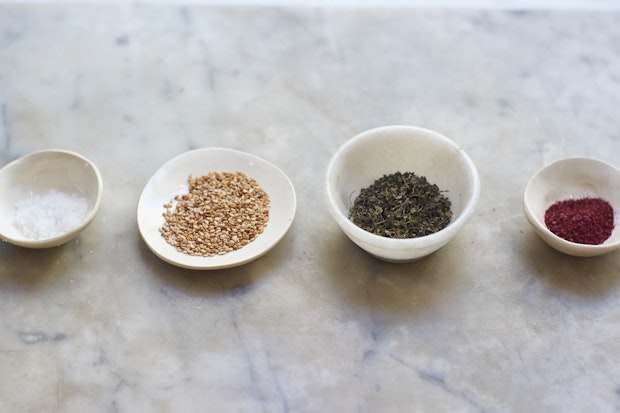
za'atar ingredients before blending
Why the confusion?
There is always some confusion surrounding za'atar because it is the name of the spice blend, and also the name of a class of herbs. We're talking about the blend here today. I believe the version I make is closest to what is typical in Lebanon, but there are times I like to add other components. 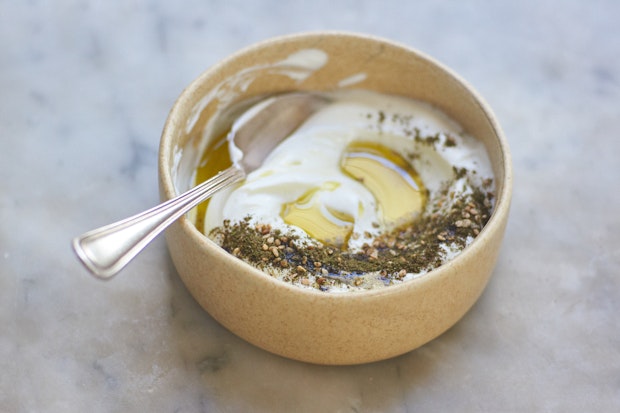
Shaping Your Za’atar Flavors
If you do a survey of za'atar blends you'll find some use marjoram, or oregano. You read of pistachios, turmeric, hyssop. Like any other spice blend, it's great to start with a good, basic recipe, but it's even more important for you to tweak it from there to your liking. I like a very thyme-centric za'atar with just enough tangy citrus reaching through from the sumac - herb first and balanced. From there, not too many sesame seeds, and just the right amount of salt.
The Za’atar Recipe
I'll include the ratio of ingredients I use in the recipe down below. But related to my point above, sometimes I add to it. I like how this Mexican oregano tastes ground into the sumac and thyme. Or, a bit of fennel pollen is a kiss of magic - particularly when I'm planning on using the za'atar swirled with great olive oil into thick yogurt or labneh. Just remember, tweak it to your liking.
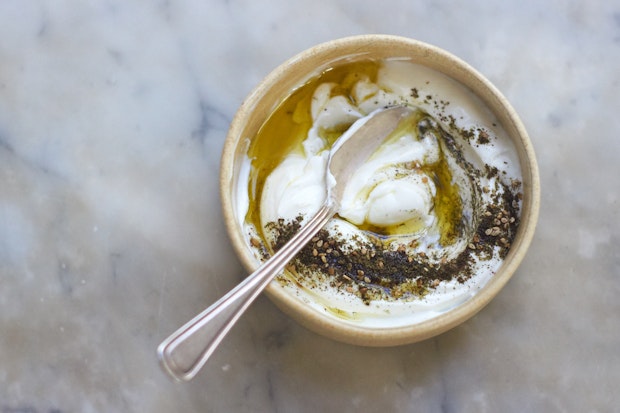
What is Za’atar used for?
Here are a few more ideas related to how you might use this herby, earthy, slightly green, sesame flecked seasoning. Za'atar can be used in place of fresh herbs in these deviled eggs. Whisk a teaspoon or two into an omelette before cooking. Use it to flavor your next batch of cottage cheese muffins. Sprinkle it generously across roasted cherry tomatoes after they are romped from the oven. Use it to finish your next grilled pizza along with a generous thread of great olive oil.
More Homemade Spice Blends
Za'atar
While you can used pre-packaged dried thyme here, I prefer to dry my own fresh thyme in the oven just before making this blend. The thyme retains a nice green color, the flavor is bright and fresh, and there is none of the mustiness you sometimes get with herbs or spices that are past their prime. It's one of those little details that make enough of a difference to be worth it.
- 4 tablespoons fresh thyme leaves, stripped from stems (or equivalent dried)
- 2 teaspoons ground sumac*
- scant 1/2 teaspoon fine sea salt, or to taste
- 1 tablespoon toasted sesame seeds
-
Place thyme leaves on a baking sheet in a 300°F oven until dry, just ten minutes or so. Just long enough that they'll crumble between pinched fingers after cooling. Allow to cool completely.
-
Use a mortar and pestle to grind the thyme leave finely. If your thyme is at all stem-y or fibrous, sift to remove any larger particles. Transfer to a small bowl, and aside.
-
Crush the sumac finely with the mortar and pestle, add the salt and crush with the sumac. Add the thyme back, and grind together a bit. Stir in the sesame seeds, taste, and adjust to your liking, perhaps with a bit more salt, or sumac, or sesame seeds. Any za'atar you might not use in the coming days keeps best refrigerated (or in the freezer) if you make a double or triple batch. Or in a light-safe container on your counter for daily use.
Makes 1/3 cup.
*If you're having a hard time finding sumac, check the spice rack at your local market (it is increasingly common), specialty foods stores and/or Middle Eastern markets.



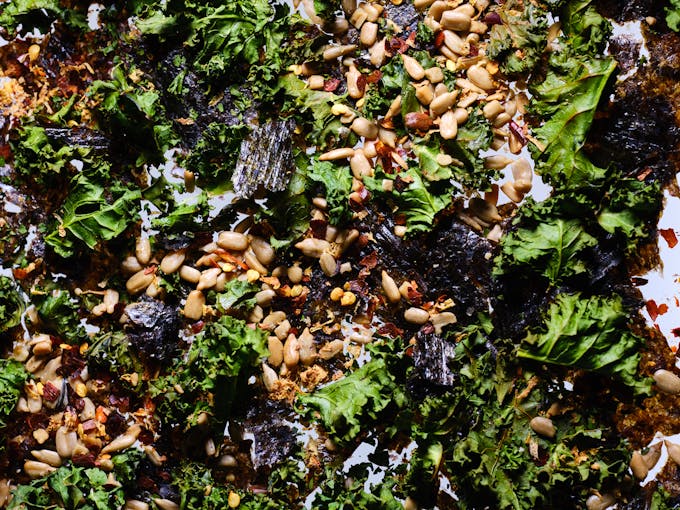

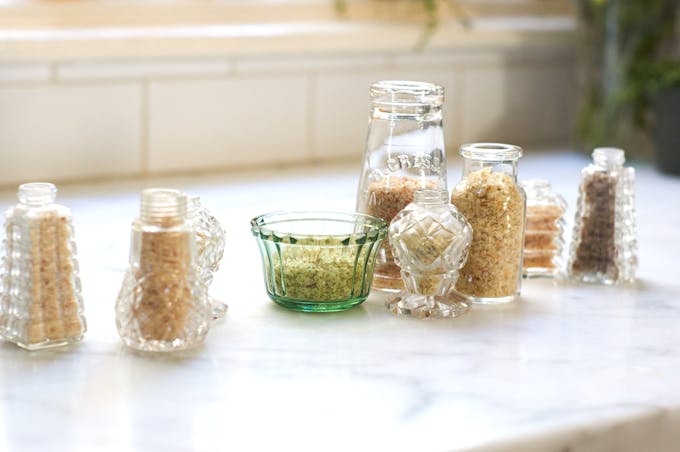
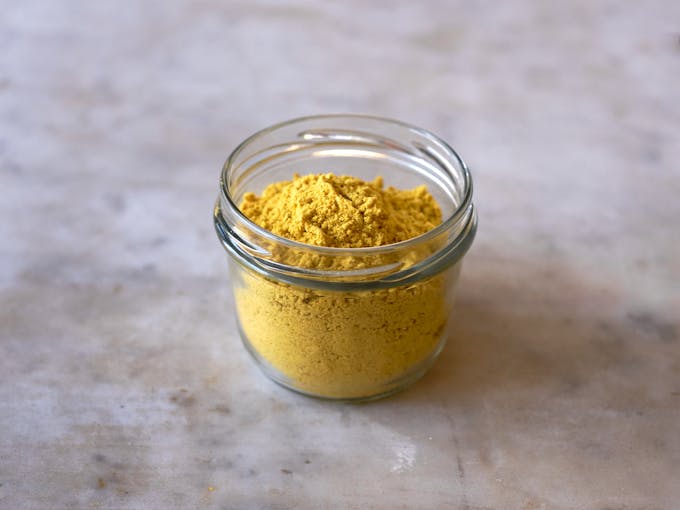
Post Your Comment
Comments
altho the zaatar may taste best made fresh, can you make a bigger batch of it and store it in a bottle in the freezer? (i’ve never heard of it before but it sounds lovely and worth a try.)
Where can I find sumac in Hawaii?
I’ve been sprinkling this on EVERYTHING but my favorite is using it to season a batch of freshly popped corn. The perfect snack for movie night!
I’ve just made a delicious aubergine dish from Yottam Ottolenghi’s Plenty book, and the za’atar sprinkled on top gives it a lovely taste. I will be trying it again with my own za’atar blend soon.
There’s a restaurant in my area name with that name. I always wondered what it meant!
the new ottolenghi cookbook, jerusalem, is (a) amazing; and (b) chock full of za’atar related recipes. everything i have cooked from it is perfect – second only to your books, heidi!
Lovely to see za-atar here Heidi 🙂 It is a very popular blend in Southern Turkish cuisine; we also love adding cuming and crushed/ground chickpeas in it, it is wonderful. Also works as a great rub for grilling vegetables. We also love dipping flatbread to olive oil and then to the za’atar (zahter, as we call it) – great treat!
I live in the Mid East – I grow my own fresh Zaatar leaves- then make the dried spice mixture later in the season- the actual zaatar leaves look like fuzzy thyme leaves- they grow closer to the ground, and are larger than regular thyme- delicious fresh in salads and roasted whole fish ..the dry mixture is excellent with soft white cheeses and eggs, on breads, and just as a dip…I really appreciate you bringing this slightly different to the American palate spice mixture forward!! l truely enjoy getting inspiration from reading your blog for new ideas all the time for real food!
Za’atar is a widely known in Middle East in general and in Palestine in particular. If you love Za’atar, you will love Manakeesh, special flat-bread with olive oil and Za’atar on top!
Za’atar is yummy! I’ve never made it with fresh herbs, but I’m going to try using fresh thyme, especially for flavoring steamed and fresh vegetables!
The best Za’atar I’ve had was brought to me by my friend, made with thyme grown in his mother’s garden in Lebanon!
Sumac, one of the ingredients for the Za’taar recipe, is a spice I use on its own merit, on all my salad recipes, even potato salad! It can be added to rice dishes as well to enhance the flavor, as used in Persian recipies.
Enjoy and happy cooking!
I love, love thyme so I am sure I will love this spice blend…. p.s. that is mortar and pestle is so beautiful!
Hi
Love za’atar. Chanced upon a jar recently in my local health shop made by a women’s co-op in the Lebanon. Love it, insanely good with eggs! I am putting it with everything too. My mix is with marjarom rather than thyme. it has been ground quite fine and the smell is fantastic. Recently I was making lamb burgers and threw some into the mix, which I made with some leftover green lentils to bind and paired them with roasted potatoes which I had covered in a cajun spice mix with cumin, paprika as they roasted. The two spice mixes paired brilliantly with each other..smoky and aromatic. Perfect Friday night with a raw kale salad.
LOVE Za’tar and use it like some people do salt – on everything. Slice an avocado and sprinkle it on – yum. With a Penzey’s spice store practically walking distance, I might be too lazy for this one… or not. Your recipes are always so good. Current favorite: Oatcakes.
Thanks for posting this recipe! I’m going to make this to go with hummus. I’ve been making a batch of hummus every week using either of Deb’s recipes on her blog.
I love this spice – buy it all the time. I make a lot of middle eastern/African food. My current favorite is an Algerian soup http://cuceesprouts.com/2013/01/algerian-tomato-soup/
I’ve had za’atar on my list for a couple weeks now – and now its crossed out and “sumac” is listed instead. thank you! I shall enjoy making this – tonight!
Great basic recipe. Thanks for the ideas – I have only really dipped oil soaked warm bread into Za’atar – how deprived am I.
Just wanted to send my gratitude for your amazing work, your gorgeous recipes, and your wholesome outlook on food which my family and I continue to love and praise. I just baked the Thinnest Oatmeal Cookies which are R I D I C U L O U S L Y good. My 13 year old promises to eat ANYTHING I make from your cookbook!! Double congrats to you on your new deal with Williams Sonoma which is a catalog that stands for quality. What a perfect pairing! Keep up the great work. THANK YOU!
Thanks for this – I’ve been wanting a recipe for za’atar for a while so I could control the quantities – there are great Middle Eastern markets here in London but I could never use as much as you get with the storebought mixes! :o) Will be making this during the weekend!
I love za’atar! I recently bought a pre-made package from the local Arabic market and have been adding to everything from chopped up cucumbers to sandwiches.
Thanks for your basic recipe. I’ll make it myself next time! 🙂
lovely post. For those who are having trouble locating Sumac to use in the mixture, I have had good luck with the Sumac I ordered from Penzey’s spices online.
You have so many amazing spice blends! And I love the versatility of them all, the way they instantly take an ordinary dish up a huge notch. Making a big batch of dukkah or “magic sauce” on the weekend makes the rest of the week so much more delicious. (I think there may be a new cookbook idea/strategy in there).
I also wanted to ask – I can’t eat sesame seeds and I imagine they contribute a lot to the flavor, do you think any other nut or seed would do the trick?
Oh. My. God. Half a day ago I had no clue what za’atar is, but then I came across it in a recipe and I’ve been all around (literally ALL around) the city (Budapest) to buy a pack. Tonight I made some feta dip using it… and yumm! It’s a very nice spice mixture, I immediately got obsessed with it!! And now I don’t need to go to all the shady places in town just to get hold of it 🙂
I have never heard of this spice blend but happen to have all the ingredients on hand to make it! I am so excited to try it today. I read all the comments and have learned many ways to enjoy it. Thank you for expanding my food knowledge with your beautiful posts.
I love Zatar!!!
This is such a beautiful spice mixture.
Gorgeous
I’ve recently come across your blog and love it. I also love Za’atar so was thrilled to see this post on making it yourself. I use it mostly when roasting veggies but you have now given me lots of ideas.
thanks, its a lovely blog
Angie
Yes lebanese. I’m portuguese but my best friend lives in ksa and is married to a libanise. I have learned with her eating bread with some olive oil and zaatar (thyme or any mixture) on top. It’s fabulous.
I can’t wait to try this. I just found out that I am allergic to dairy and eggs – can you imagine?! So I am looking for new ways to invigorate my cooking and add new depths of flavor.
Great! I’ve only tasted this in hummus and I had no clue how to make it! I’m so glad to know now and be able to recreate the hummus that I loved so much!! 🙂
OH, I love Zatar!! My lebonese friend used to buy buttermilk biscuits, pound them flat, then bake with a mix of zatar and olive oil on top. I still do that. So yummy!
Popcorn! Za’atar is wonderful on popcorn.
Here in SF you can find it either at Rainbow Grocery or at Haigs Middle Eastern Deli on Clement St. Haigs is a good resource for some hard to find herbs.
I remember reading this enlightening article about the simplicity and complexity of zaa’tar. Who knew that there’s a zaa’tar boutique in Amman, Jordan?
http://www.saudiaramcoworld.com/issue/201203/thyme.travels.htm
enjoy!
Being of Syrian decent, my mother makes bread (shaped like pizza) with za’tar sprinkled on top, quite frequently, and I have always enjoyed it. In Arabic we call it hibiz za’tar.
Thanks for sharing this, I’m a big fan of za’atar!
Glad to see Za’atar featured on your blog. i too grew up eating zaatar sandwiches for breakfast and now serve it to my little boy on weekends spread on whole wheat naan that has been warmed in a hot over until soft and pliable. In Lebanon, the thyme used to make za’atar is foraged for in te mountains. It is not the thyme that we have here in the US but rather a middle eastern oregano known as Origanum syriacum. It is pungent and citrusy and oh so delicious. Also, one may find at middle eastern specialty stores another blend of za’atar known as Aleppine Za’atar which is a special much sweeter recipe developed in Aleppo, Syria and equally delicious.
I love the idea of making my own Za’atar! I have never thought to make it myself, but it seems so easy. I love it on pita chips. Yum!
Wow, this is fantastic, thank you! I love za’atar and buy it in big bags at the Middle Eastern grocers here in Chicago. I won’t make a batch of hummus without it–both blended in and sprinkled liberally on top–and I suspect that this homemade version is better than what I’m used to!
I love za’tar! I can’t believe I never thought of making it myself; bottled as a gift, it’d be a great way to introduce friends to it. Question: where do you get your fennel pollen? That sounds all-around fabulous, but it’d an an extra something here especially.
Cheers!
I’d never heard of za’atar but saw the notation of it being found at Whole Foods.
Had a hard time finding it at WF–but thought I’d give your readers a tip. It’s in the “bulk spice” section in a tiny green box by “spicerly.”
It smells heavenly. Thank you for sharing!
Being lebanese, I confirm that this is the lebanese mixture. In fact, Za’atar means thyme but we use the word for the mixture of thyme too. Its very good when simply spread with olive oil on bread. You can add some tomatoes and mint leaves. At breakfast, we eat what we call Man’oucheh which is a lebanese bread dough (pita) that went to the oven with the Za’atar and olive oil on top. Delicious!
I love sprinkling it onto challah bread before baking … And an interesting mix idea is to add a bit of brown sugar.
A lebanese friend introduced me to za’atar several years ago, explaining that lebanese children often eat it with breakfast to “awaken” the mind and prepare it for learning. Now, I can’t even imagine eating scrambled eggs without za’atar sprinkled on top! It’s become such a morning luxury. (I also enjoy the cumin-based syrian blend for a more earthy flavor once in awhile.) Thank you for encouraging us to embrace this spice for ourselves and infuse our own blends with personal flavors. I’m so glad more and more people are waking up to the pleasure of this aromatic delight!
Ha! “Some confusion,” indeed. I read about za’atar a couple of years ago, and as I had recently moved to a big-city neighborhood with a large middle-eastern population, I went to one of our local grocery stores and asked for it by name. The man helpfully walked me to the large herb and spice selection and basically waved his arm. When he saw my confusion, he said that za’atar just meant “herbs” in arabic.
Okay, so when I was in a different grocery store, I asked for za’atar and the young male clerk told me that was the name for oregano. Too bad women don’t usually staff such stores. I might have more easily found what I was looking for (which I did eventually). Of course, the same term can mean different things across cultures and countries.
Heidi, I can’t believe how many interesting things you open my eyes to. Am I the only person in the world who has never heard of this spice before? I’m familiar with the taste of each ingredient taken separately but the combo of the three must be superb. I’ll be making this and showing it off to my friends. P.S. I know you are not a meat lover (forgive me) but I can see za’atar, honey and lemon with barbecue beef or chicken. Thank you for your precious recipes. Elvira.
I love love Zaa’tar…. I use less sumac and spin hour 2 of salt coze manaeech are much tastier when they are a little salty…. I bring mine with me from Lebanon, they are homemade and so yummmmmyyyyy.
The Palestinians I know sprinkle za’atar over rolls before baking. Served with afternoon tea or whenever you want a little snack that is savory, not sweet. I will bookmark this for the spring, provided my thyme patch has survived the mind-bending cold we’ve had this month;)
Thanks for that recipe. I’ve been craving Za’tar these days, and now I can even make it myself. Brilliant! Can’t wait to dip cucumbers and fresh pita bread in it.
I was first introduced to Za’atar by my friends at http://www.wholespice.com and like you, I can’t get enough of it or find a use I don’t like. Kids love it on Pop Corn and a hint of butter….! So excited that you wrote about it.
This blend sounds so easy, and so worth it! I’ve definitely eaten premade za’atar, but I’m super excited to try making my own. 🙂
Za’atar is a favourite of Yotam Ottolenghi’s; he sprinkles it with fresh pomegranate on top of baked aubergine (eggplant) and a dollop of his buttermilk-yoghurt-garlic sauce. Heavenly. As are most of his recipes, of course!
I have recently discovered a new “gourmet” blend that is made in the Cedar reserve in the Chouf mountains in Lebanon; it contains pine seeds and no sumac and the zaatar used is not ground as it usually is, but whole leaf. well it is extraordinary. Someone recently asked me to ship it to them (it is not cheap, even here in Beirut) and he raved about it.
Heidi, how is your thumb? I must know. I wanted to tell you to save the piece that was cut! I know, gross. But thumbs have an amazing power to heal themselves — I had my own mandolin experience a few years ago, and the lines are still visible (three little cuts), but my thumb is intact. No nerve damage, amazingly. 🙂
The recepie I got on a Lebanon trip was w half thyme, half savory. Unfortunately dried savory is impossible to find in Sweden nowadays, but it tastes great w all thyme well.
Must say I LOVE your blog, sooo inspirational!
I love love love sumac! It is so underused but has that impossible to replicate with any other dried spice zip!
A friend of mine just sent me a zip-lock bag of za’atar from Lebanon, since I had raved about how much better it tasted on baked pita pocket-chips than oregano. I opened the care-package in front of someone who works for my husband. He now thinks I am a stoner….. Your post is quite timely since I was just going to ask her what it was made of and what else I could use it with. Thanks!
I bought this spice blend at Williams&Sonoma last year then really didn’t know what to do with it. Could you or anyone give a few more examples of how to use it or where to find recipes that call for it? Thanks so much! One thing I do use it for is on top of Naan bread when I warm it in the oven—rub a little olive oil on the bread then sprinkle the Za’atar on it.
Perfect thyme-ing 🙂 I have been wondering how else to use the bunch of fresh thyme I have in my fridge! I also LOVE za’atar. This is perfect. Thank you!
Heidi,
I am middle eastern and grew up eating Za’atar. I have wonderful memories of my father and I sitting around the breakfast table with a dish of beautiful olive oil and Za’atar always out, accompanied by my mom’s fresh pita bread, Arabic cheeses etc… Whenever I make it at home, these memories are always conjusred up! Thanks for the reminder. 🙂
I love all of these spices separately but have never used them together nor have I heard of Za’atar. But this mix sounds great- thanks for sharing it, I will definitely try cooking with it this winter!
xx Kait
ChickadeeSays
i bet this would really pump up my slow baked cashew cheese!! gonna try that and the pizza dough recipe, too! thanks from one very happy to receive vegan : )
what a great reminder! have some right here and haven’t been “seeing” it. this blog always pops me into a fuller awareness of my kitchen and inspires. xo
I have never seen a recipe for Za’atar before although I too really love it and just recently found sumac at our Bulk Foods store and have been sprinkling it on top of salads. I grow and dry my own thyme, so have that already waiting for the other ingredients to create a bit of magic. It will be wondeful on hummous! Thanks so much, Heidi.
Ever since I sprinkled it on an avocado sandwich I find it impossible to enjoy avocado without za’atar…well, almost. 🙂
I just discovered za’atar last year and loved it immediately. Another use I’ve found for za’atar is for grain salads. I prepare the dressing first and add za’atar to the dressing. Then I prepare the salad. By the time I’m ready to dress the salad, the za’atar has made the dressing even more delicious and gives another layer of flavor to the salad. I look forward to trying your recipe for za’atar, Heidi, thank you.
I love za’atar but never make it myself. D’oh!
My favorite quick what-am-I-going-to-eat-right-now thing is a “zaatar-dilla” – just cheese, za’atar and tortillas. Thanks so much for sharing!
I’ve been wanting to try this since hearing wonderful reports on the stuff from my brother and his wife while they were living in Damascus. Thank you for a recipe! I’m particularly excited to pair it with some roasted kabocha squash!
Nothing enhances the flavor of freshly sliced ripe tomatoes like Za’atar
I’ve made this spice blend before for an Ottolenghi recipe in “Plenty” and I’d like to thank you for the reminder to make some again soon!
I always enjoy learning how to make new spice blends. I love making them and having them on hand! This sounds great and very versatile!
I like the idea of mixing my own za’atar. Also, thanks for the oregano link with the nice Yucatan toasting tip.
I’ve heard of this before though I didn’t know the correct name. this spice blend intrigues me a lot. Unfortunately I couldn’t find sumac, I used tumeric instead, and I enjoyed this combination (tumeric tyme and sesame seeds) dissolved in some good olive oil. Used it to brush some homemade pita bread!Thank you for sharing these awesome ideas!
Roberta
My husband loves Za’atar for that tangy quality you mentioned, and I used it most recently in a dish of sauteed shrimp and chickpeas. Because of his enthusiasm, I’ve been trying to think of other ways to use it, and stirred into yogurt with olive oil looks like a great idea.
Heidi, thanks so much for sharing your za’atar! I grew up on za’atar in my Lebanese family and just wrote about it recently with crunchy roasted chickpeas on my blog:
http://www.maureenabood.com/2013/01/10/crunchy-roast-chickpeas-with-zaatar-good-and-good-for-you/
Also try it on fried eggs, or sprinkled over labne on a crostini or pita chip for a great app. So good!
Thanks for the recipe. I bought some Sumac recently and wasn’t sure what I wanted to do with it. Will definitely try this out!
Our friends Suha and Izzat make what is essentially breadsticks rolled in za’atar. Simple and so, so yummy. Now, I’m inspired to make this recipe for just that purpose.
Looks like something I need to try! Thanks!
What a good idea to dry your own thyme, I will be trying that. I have to say that on lazy days, pita bread with lots of olive oil and za’atar is my dinner!
I recently returned from a women’s trip to Israel, where we went to a spice farm that made a dozen different types of za’atar. I had never used it before, but fell in love with it! I was wondering what I would do when my supply ran out- now I know!
This Za’atar recipe looks really great. Do you have a Fo’ol Recipe, the breakfast food?
I, too am in love with the flavors of Za’atar! I usually buy big bags of it from my favorite mid-eastern grocery, somehow I’ve never thought of making it myself! (I make my own curry, chili powder, etc-) Thanks so much for the recipe I will be putting it to good use for sure!!
I use zaatar also sprinkled on leg of lamb with some soya sauce and a bit of water. I also make some holes and insert some garlic in. Cover with foil and bake 30min on 250 degrees Celsius and the lower to 170 for about 2 hours… I think I have it in my blog somewhere (sinmatok).
zaatar in the middle eastern is thyme itself, although they sell mixes like the one you describe. And they call those zaatar mixes. But again zaatar means thyme – زعتر
I read about za’tar in one of Ottolenghi’s book and I was so curious about it!!!I didn’t find it, so I think I will follow your recipe to make my own za’tar!!
Thanks a lot for your tips!
I use Za’atar so frequently to add a memorable and addicting flavor!
Never had this before. I never had sumac either. There’s definitely some catching-up to do!
Nice! When I traveled to the middle east as a teenager, I picked up some za’atar and gave it to my mom so we could try some recipes. I found the package sometime this year unopened! Of course it is old now, so I would like to try and make some fresh. Also, we have tons of packets of sumac from a restaurant that we get take out from frequently. Do you think this would be usable in the recipe?
I like the idea of using it with eggs, and mashed avocado as well! The idea of pizza dough or in a watermelon feta salad from a fellow reader sounds great too!
I was pretty ignorant about the contents of Za’atar until I read this post. I’m definitely going to give this a try. Thanks for the inspiration!
Here is Jerusalem it is VERY common, its pairs amazing with toasted breads topped with cheeses like cottage, goat etc. and a drizzle of olive oil
I’d definitely like to have this on hand. I’m sure I’d end up using less salt if I did! Plus, I love thyme and sesame and the combination sounds fantastic (especially on eggs…yum.)
Za’atar is good for breakfast with pita bread- just dip bread into olive oil and then into the za’atar. Also great for a summer time snack with cold, crisp watermelon and salty feta cheese. For a speedy snack I mix za’atar and oil and spread it on rolled out pizza dough and bake. Its like middle eastern foccacia. Yum!
Lovely! I like to stretch out a fresh ball of pizza dough, then top with extra-virgin olive oil and za’atar. Bake until golden a fragrant. So delicious!
Hi Heidi,
I’ve been a long time follower/lurker of your blog and your cookbooks are well used in my kitchen, with postits poking their bright little flags from the pages of recipes to try and special favourites. It looks like I might be the first comment, so I thought I’d shun my lurking status and make a post!
I thought I’d take the time to tell you how much I’ve loved every one of your posts since I stumbled upon your blog several years ago. I’m not a veggie, but your natural and whole approach to food has changed how I cook and look at my diet. I always recommend your blog to foodie friends (and random strangers). I’m going vegan for 2 months starting February 1st (as an experiment) and I know that wonderfully exotic spice blends like this will help keep my food interesting and keep me from missing the meat.
Keep up with the posts! Love from chilly Toronto, Sharon
HS: Thanks for the kind note Sharon. I have to tell you, one of my favorite things is when people come to a book signing and my book is all flagged with post-its and notes and the like. Feels good. Give this spice blend a go – it’s incredibly versatile. I don’t think I mentioned it up above but I love it on brown rice, and/or farro too. Also great with lentils.
I bet this would be good on everything from mashed avocados to tofu to potatoes to squash to whatever…It sounds fabulous and I need to give it a whirl!
More Recipes
Weekly recipes and inspirations.
Popular Ingredients